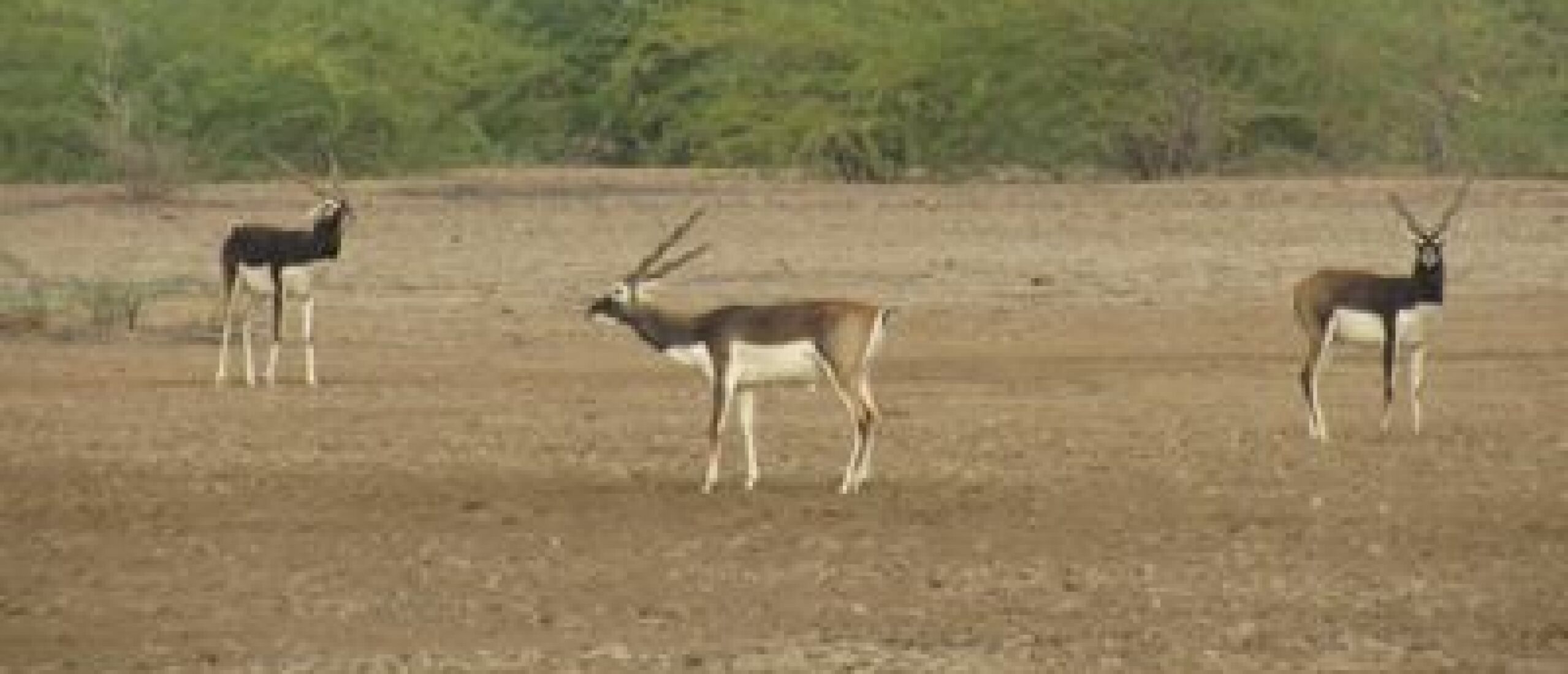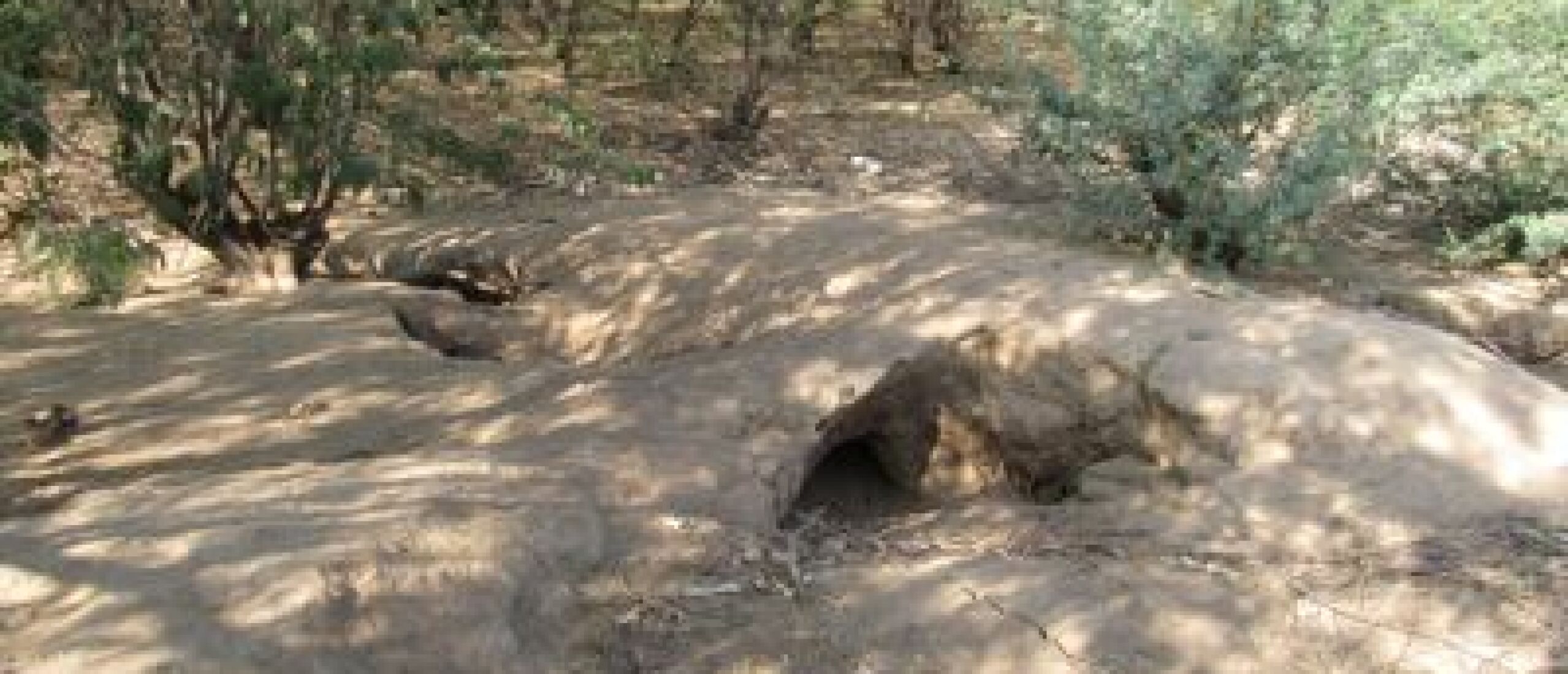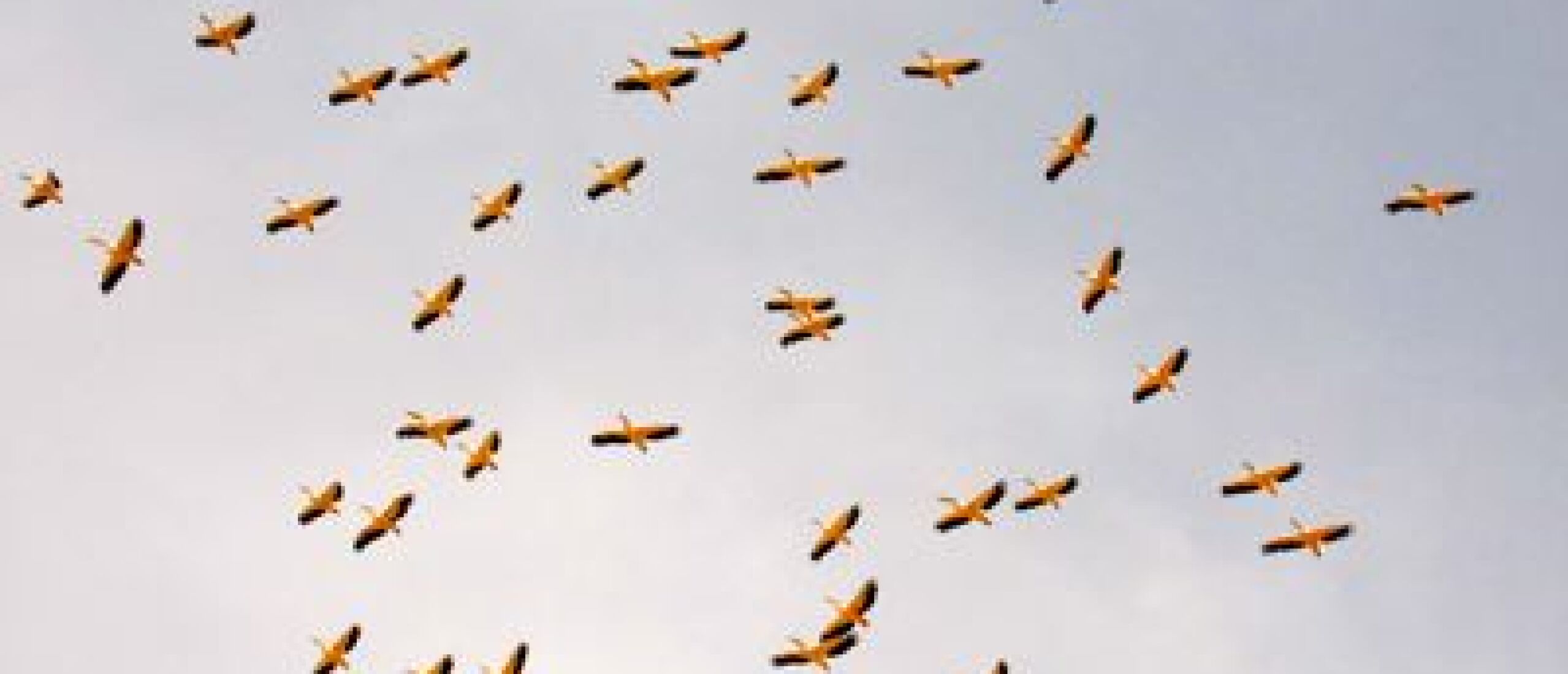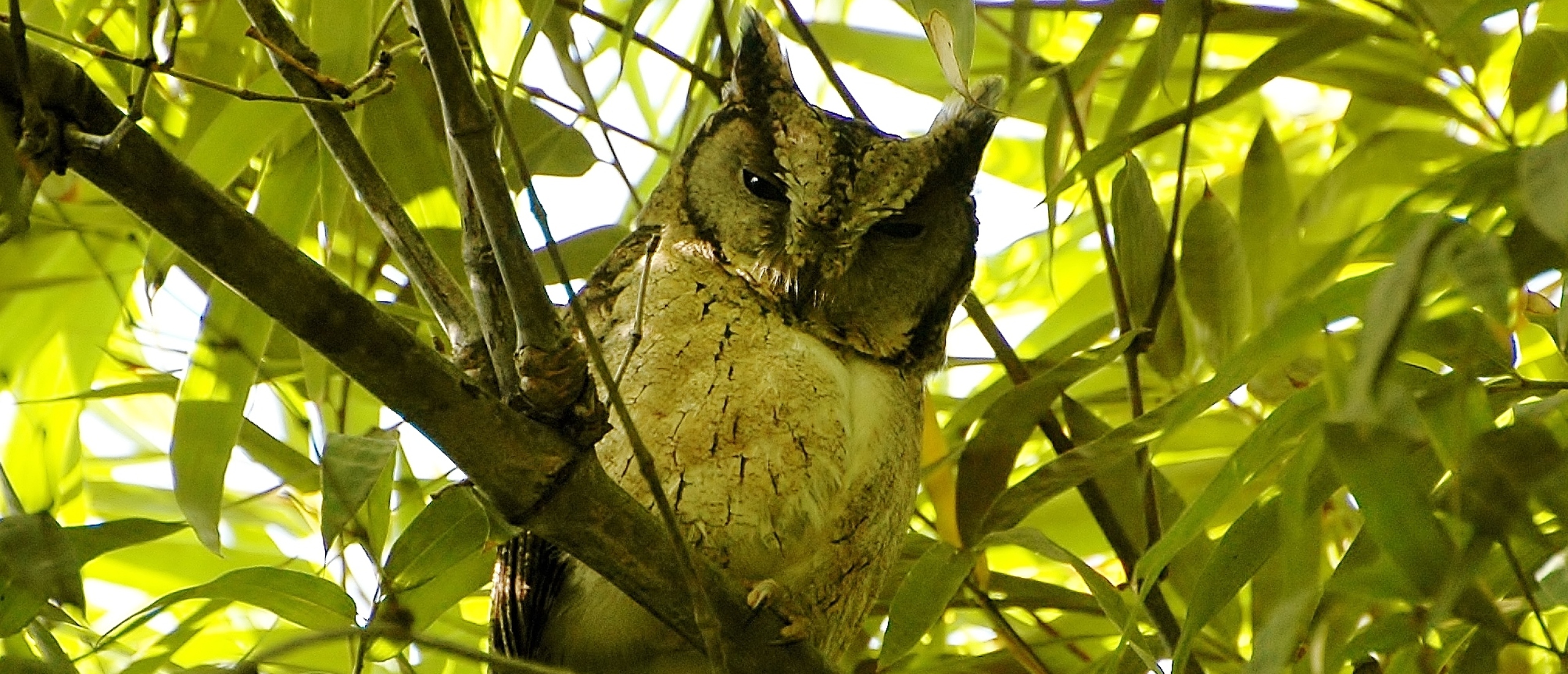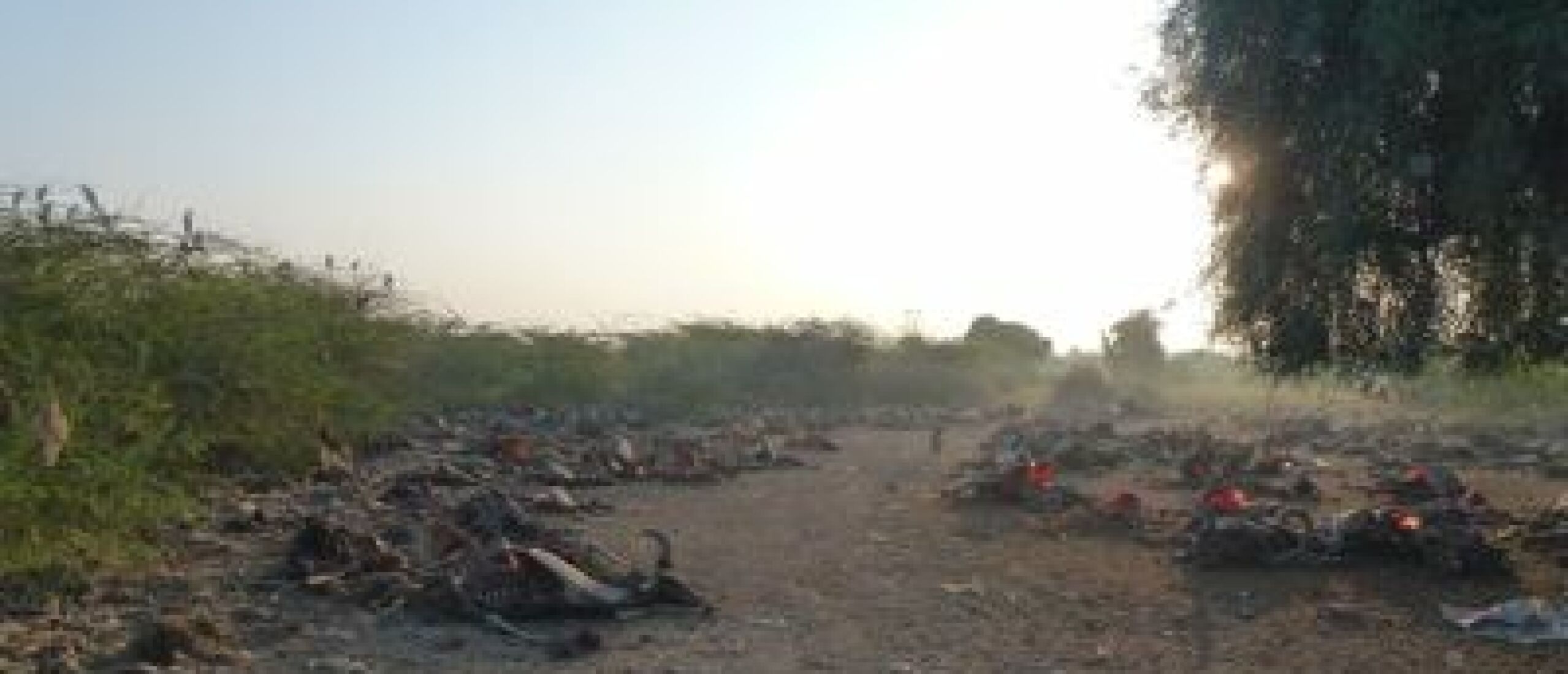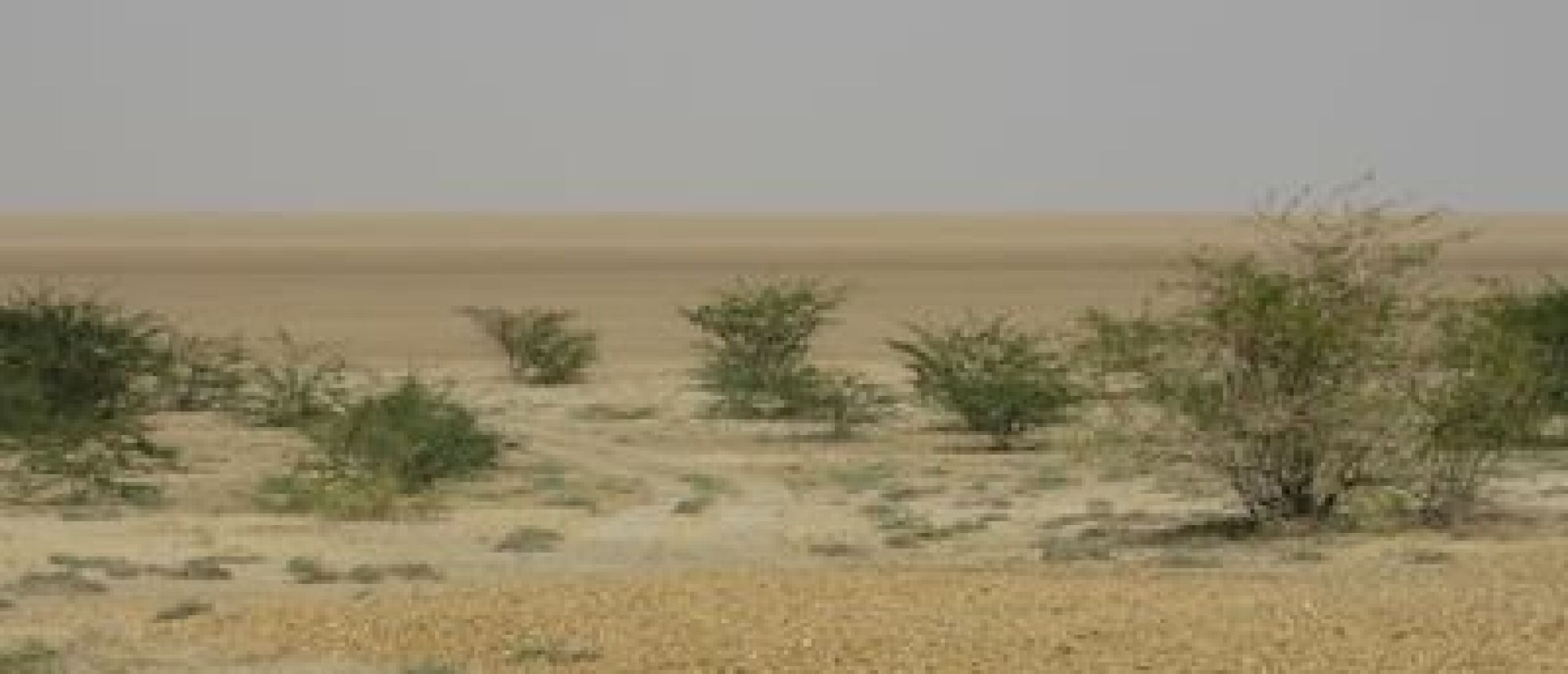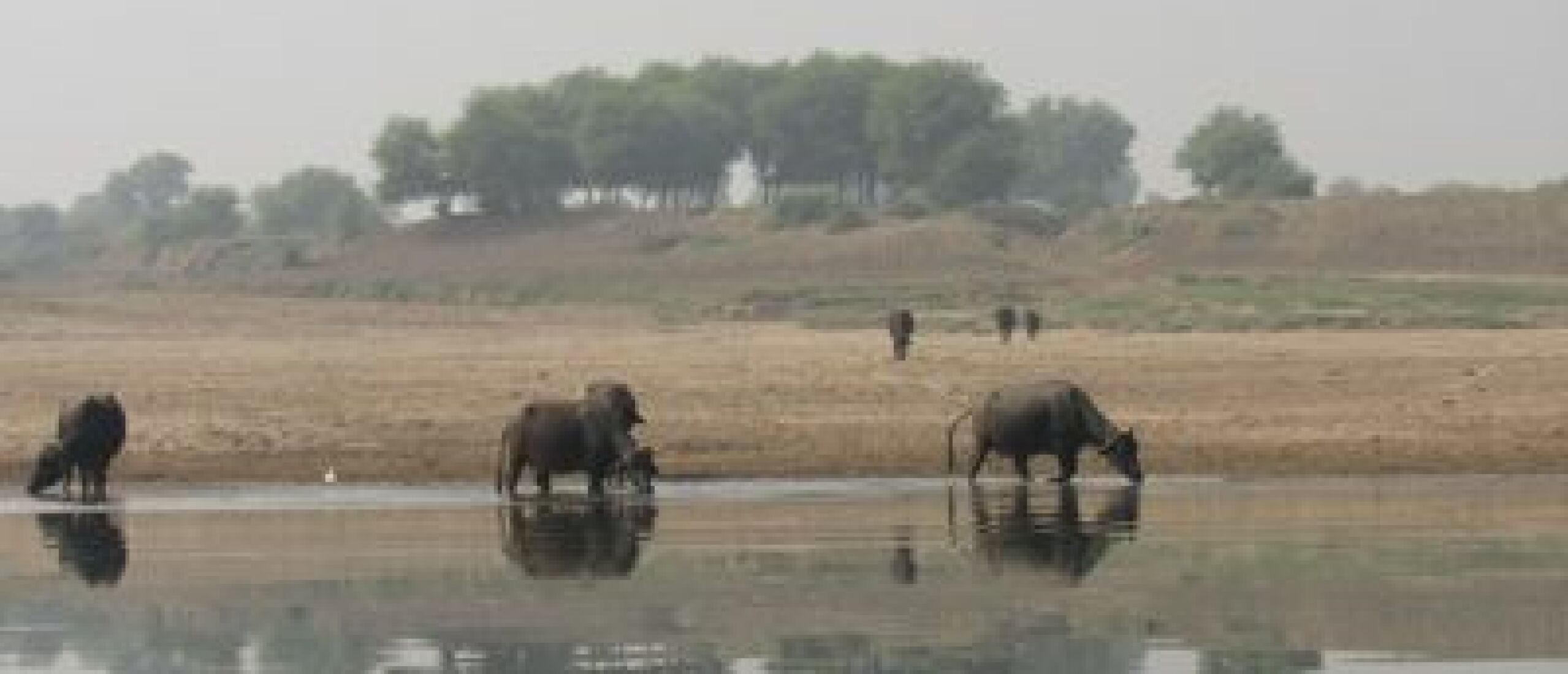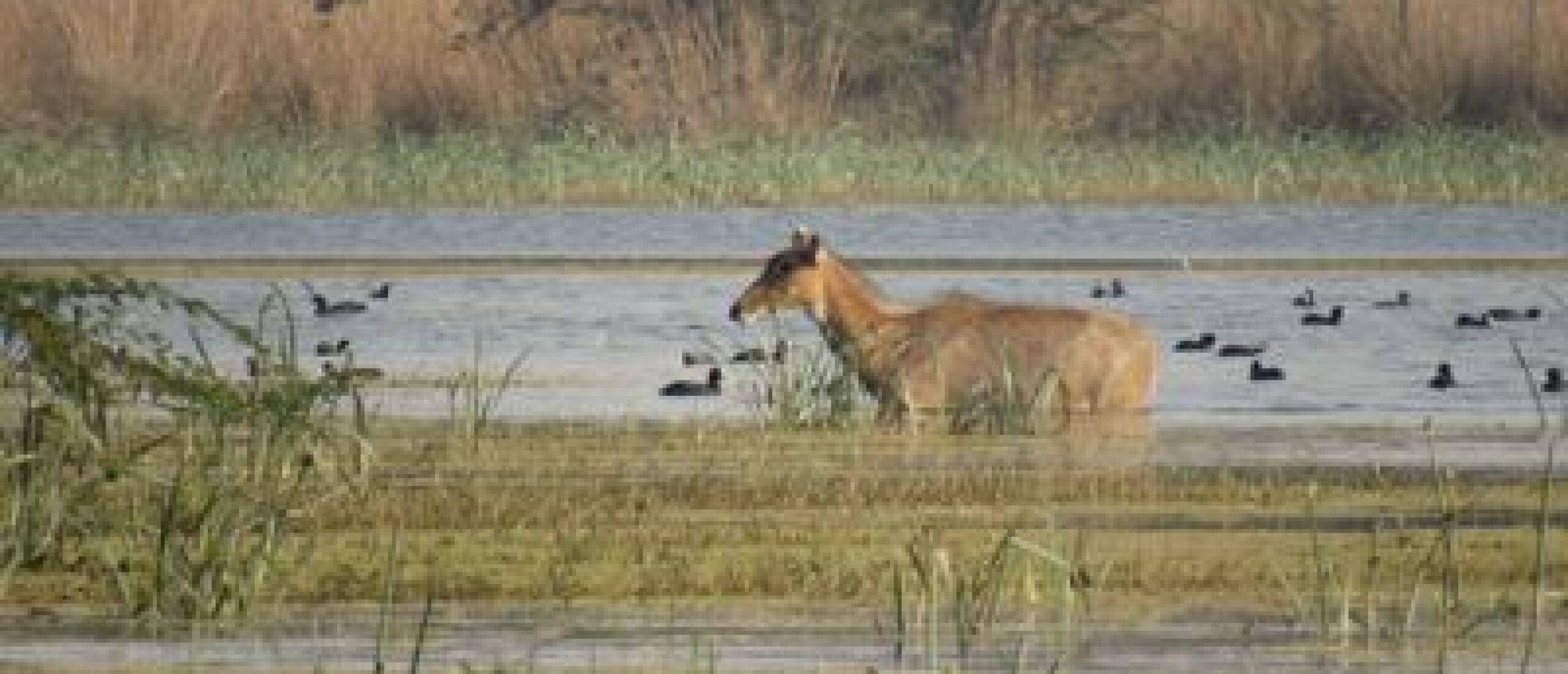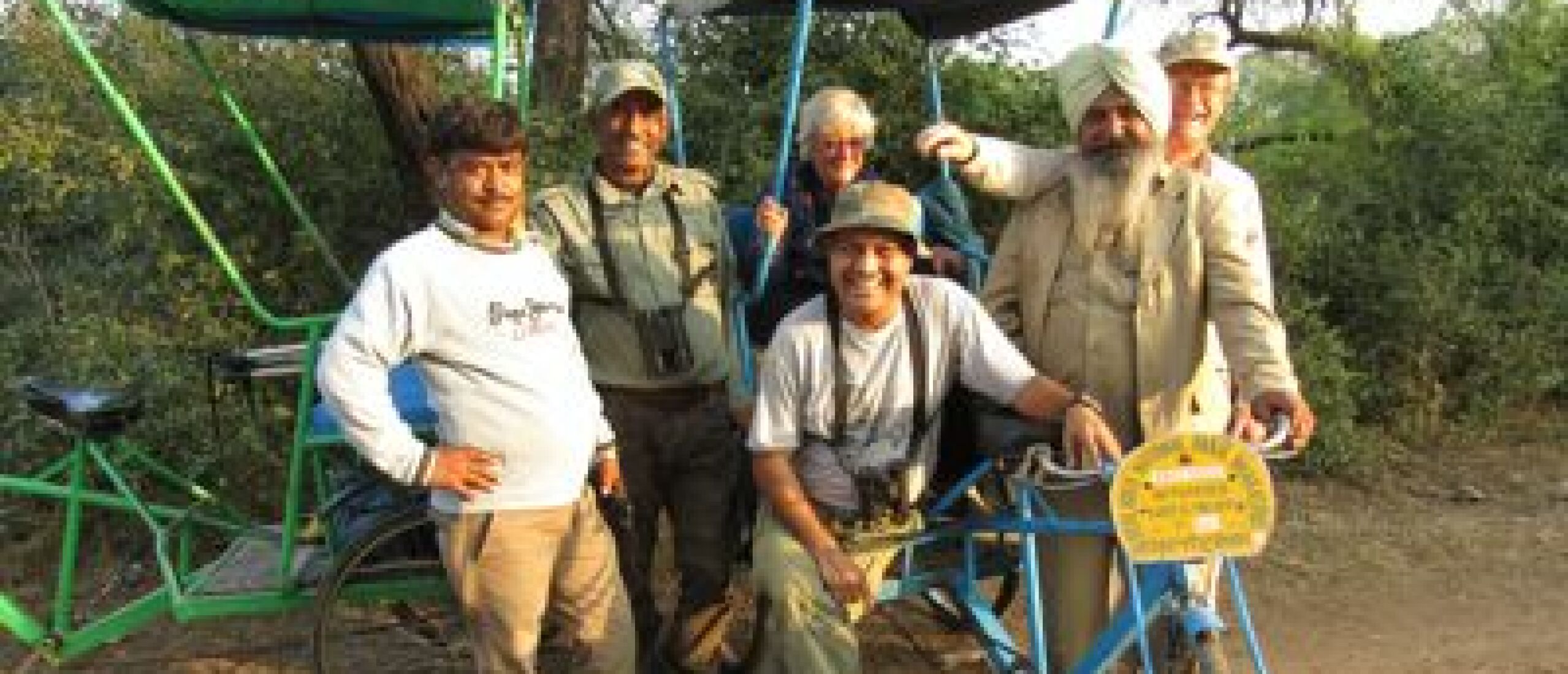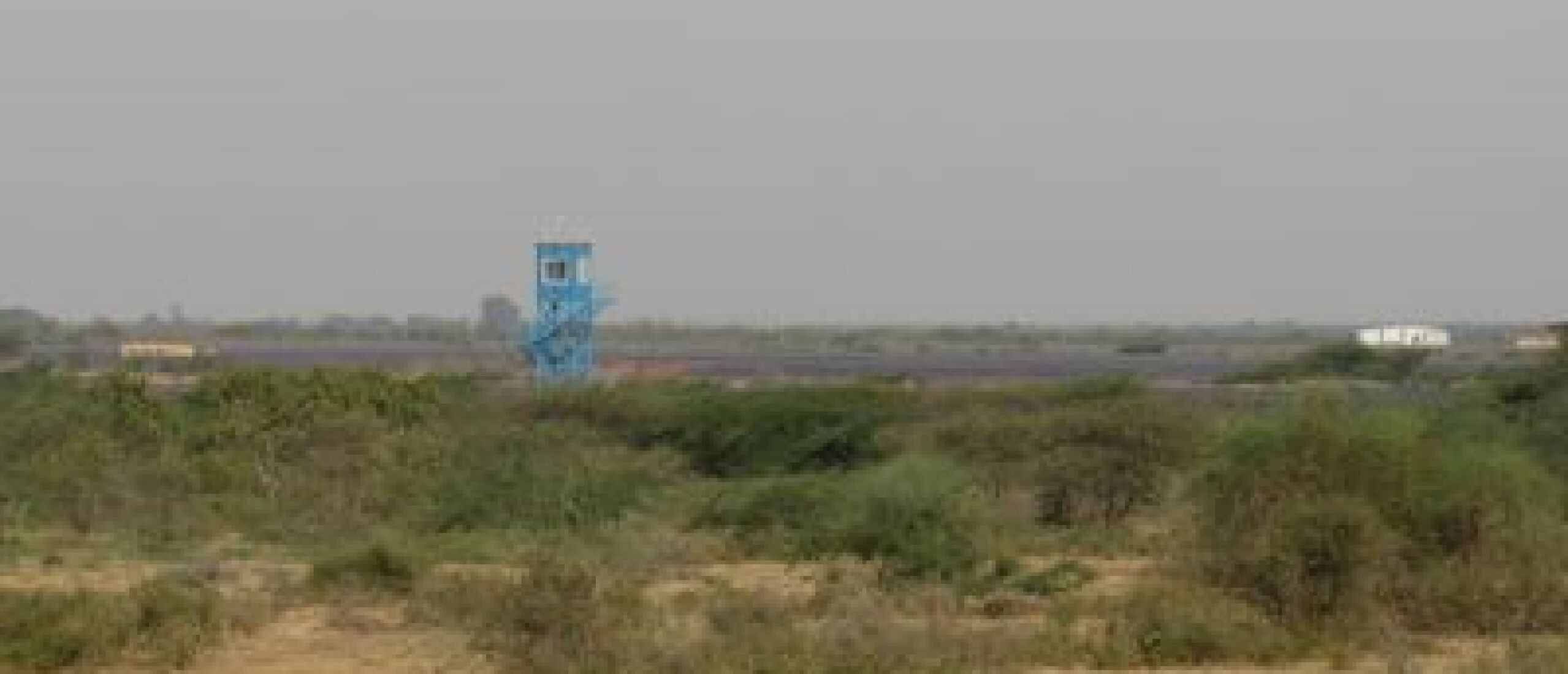
The Great Indian Bustard, a stately bird walking into extinction The morning after our Sykes's Nightjar and Desert Cat sightings, we were off before dawn on a mission that was to lead us to encounters with two absolutely top quality birds, one even more endangered than the other. A brief dawn stop on a road bridge to check a river beneath turned up an Eagle Owl perched in an unusually easy spot - and easy to point out as well, as it was close to a very conspicuous plastic bag; for once, plastic trash, of which there is so much in India, was useful for something! The Indian Eagle Owl is smaller than its European counterpart, but impressive nonetheless, and we spent some time photographing it, although the light was still poor and really sharp images seemed to be unobtainable.
 The Indian Eagle Owl was easy to point out thanks to the plastic bag hanging next to it
The Indian Eagle Owl was easy to point out thanks to the plastic bag hanging next to it
Shortly afterwards, we branched off the main highway and entered the Naliya grasslands, a highly important bird area, and an oasis of natural savannah and acacia woodland in an otherwise agricultural zone. It was only a few moments after we had started searching that I spotted a large sandy bird running on longish legs through the grass between two Acacias, and a shout of "McQueen's!" escaped my lips in my excitement! It was a McQueen's Bustard, a species split from the better known Houbara Bustard, which I had seen on Fuerteventura, in the Canary Islands, some years previously. These extraordinary birds are highly endangered, suffering appalling levels of hunting pressure, particularly from Arab falconers, who will pay astronomical amounts of money to corrupt officials, especially in Pakistan, to turn a blind eye to their hunting of this supposedly protected species.
 The McQueen's Bustard kept its distance from our vehicle
The McQueen's Bustard kept its distance from our vehicle
Seeing this single bird was a privilege indeed, and we watched it for some time as it stalked through the grass, always keeping a wary eye on us. Unfortunately, these bustards are fairly easy to approach in a vehicle, which is what the Arab falconers do, releasing their falcons for the final dash, taking the cumbersome bustards by surprise and not allowing them time to escape. Elated at this success, we could hardly have expected more, but suddenly Yogi exclaimed in a state of high excitement, " G I B!" Well, the G I B referred to perhaps one of India's most endangered and extremely rapidly declining birds, the almost mythical Great Indian Bustard. I was so anxious to see this huge bird that despite Yogi's careful directions, I could not see it. It turned out that I was looking too near, and it was in fact in a further field. But once I had finally latched onto it, there was no missing this huge and boldly marked bird, which was a full adult male, complete with black cap, pale grey neck and sandy wings. We leapt back into the vehicle and bumped our way closer, forcing our way through patches of thorn scrub, until eventually we reached the area where we thought we must have been seeing this great bird, but initially there was no further sign. Finally, however, a movement in the grass and a flash of pale grey neck allowed us to relocate the bird, but he then hid behind a surprisingly small bush, becoming totally invisible but for his bill and his eye. Each time we moved, so did he, keeping the bush between us and him, but after we had remained still for what seemed like an age, he plucked up courage to stand up, and stalked out from his hiding place, and he then proceeded to walk off and then away to our left, allowing me to film him for around 3 minutes as he strode away.
 The Great Indian Bustard hid behind a bush in the hope that we would not spot it
The Great Indian Bustard hid behind a bush in the hope that we would not spot it
The Great Indian Bustard is such a charismatic representative of its dry grassland habitats, and such a magnificent creature, that it should not be allowed to disappear, and it would be a national disgrace for India to lose such a bird. It is the bird equivalent of the tiger, and an all-out effort is now urgently required if it is to be saved. Mr Tiwari, who has been campaigning for the conservation of the Great Indian Bustard in this area for two decades or more, informed us later that in all those years he had never seen a young bird. Missing the chicks in the long grass might be possible, but as the bustards take seven or eight years to reach maturity, he would certainly have come across juvenile birds if there were any. So the birds that still exist are now old stock, and no longer able to breed successfully.
 The Bustard then stalked away through his already fragmented habitat
The Bustard then stalked away through his already fragmented habitat
The causes of the demise of this species are numerous. Most immediately obvious to us was the presence of a large solar farm that had recently been built, on officially protected grassland, the land having been leased by politicians at a knockdown price to foreign electricity generating companies. Bustards need extensive tracts of undisturbed native grassland, which they had here in Naliya until recently. Solar power may be a supposedly green form of energy, but these vast plants should not be placed in prime bustard habitat.
 Solar plants may seem ecologically friendly, but NOT in prime Great Indian Bustard habitat
Solar plants may seem ecologically friendly, but NOT in prime Great Indian Bustard habitat
The second problem faced by these ground-nesting birds is disturbance during the monsoon by cattle-herders, who bring their huge herds to feed on the lush grass in the bustard habitat. Nests are trampled or eggs taken by the herders' dogs. A fence has been built, but there are huge gaps in it, affording the birds no protection at all. Help from Birdlife International or other organisations could surely fund the completion of the fence, but then there is the problem of official complacency. We came across a Forest Guard who was scanning the area with binoculars, and he was delighted to hear that we had seen one bustard. Apparently top officials, perhaps from the Forest Department or the Gujarat Government, demand to be shown Great Indian Bustards when they visit, and the pressure on the junior staff to find the birds is huge. If they do, then the records are used to 'prove' that the species is still present, and even doing well. And shockingly, if they do not, these junior staff members are liable to be sacked. It all sounds rather like the official denials of the disappearance of all the tigers from Sariska National Park, when for years, officially there were still tigers present, although in reality they had all been poached out. If the Great Indian Bustard is to have a future, then everyone involved needs to pull together for the benefit of the birds, and not to get bogged down in politics and denial of the problem. As I filmed the great bird stalking its way across this fragment of its originally extensive habitat, looking so stately and dignified, as it walked finally out of shot, I feared that I was watching this magnificent creature striding into extinction. I appeal to all concerned not to allow that to be the Great Indian Bustard's fate.
 The Great Indian Bustard seemed to be walking towards its own extinction
The Great Indian Bustard seemed to be walking towards its own extinction


